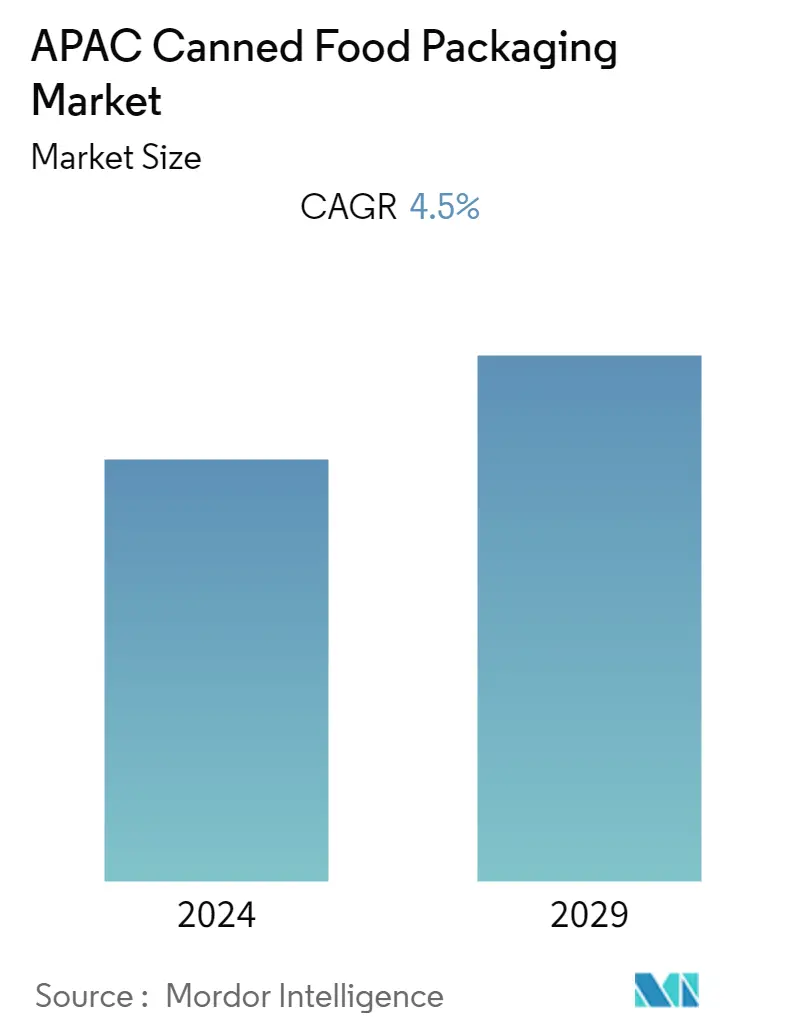Market Size of APAC Canned Food Packaging Industry

| Study Period | 2019 - 2029 |
| Base Year For Estimation | 2023 |
| Forecast Data Period | 2024 - 2029 |
| Historical Data Period | 2019 - 2022 |
| CAGR | 4.50 % |
| Market Concentration | Medium |
Major Players
*Disclaimer: Major Players sorted in no particular order |
Need a report that reflects how COVID-19 has impacted this market and its growth?
APAC Canned Food Packaging Market Analysis
The Asia Pacific Canned Food Packaging Market is expected to grow at a CAGR of 4.5% during the forecast period (2021-2026). Canned foods are preferred more because they are readily available in the market and are an essential part of the diet of many individuals, which will play a key role in boosting the market growth of canned foods. Moreover, as canned foods of good quality are coming up, the demand is further increasing, also bolsters the market.
- Hypermarkets/Supermarkets are the primary channels of distribution of canned food in the region. Wider availability of products under one roof, ranging from soups to meat products, has fueled the growth in the sales channel. Supermarkets sell products at a competitive price to expand their consumer base. Bundling products has been a popular strategy that has promoted the growth of products, such as instant noodles, ready meals, and canned soup. Walmart, Carrefour, Metro Inc., Ito Yokado, AEON, the Tokyu Store, 7-Eleven, and Woolworths are the major superstores in the region.
- Growth in the canned food packaging market is directly proportional to changes in the food industry and the costs associated with packaging. According to Australian Statistics Bureau records, Australia's canned food market has grown significantly, with food retailing up 12% to AUD 151.34 billion. However, increased material costs can hinder the market growth during the forecast period.
- Consumer demand for convenient canned food products that are healthy, ethical, and comforting, and fit for fast-paced life is increasing in developing economies. Moreover, the rise in disposable income in emerging economies such as China, India, and Brazil has increased expenditure on time-saving and labor-saving canned food products. According to the National Bureau of Statistics of China, the annual disposable income per capita of urban households has increased by more than 100% in the last ten years, reaching RMB 43,834 in 2020.
- Southeast Asian countries like Malaysia and Thailand are expected to generate lucrative sale opportunities for canned food products due to the emerging tourism sector seeking packed food, whether metal or steel packaging. Therefore, hotels ensure providing packed canned food, especially canned meat, due to its perishable nature. Airtight packaging brings imperishability, ensures the product's long shelf life, and positively influences canned food demand.
- The spread of COVID-19 spurred the demand for canned food across the Asia Pacific region due to increased dry food procurement backed by hygiene concerns. However, the market cannot wholly capitalize on the sudden demand influx due to a complete lockdown and suspension of the production activities, which hindered the market's growth during the year 2020. Further, since health concerns are likely to be sustained even after the disease outbreak registers slowdown, sustained growth of the market is expected to be witnessed in the coming years.
